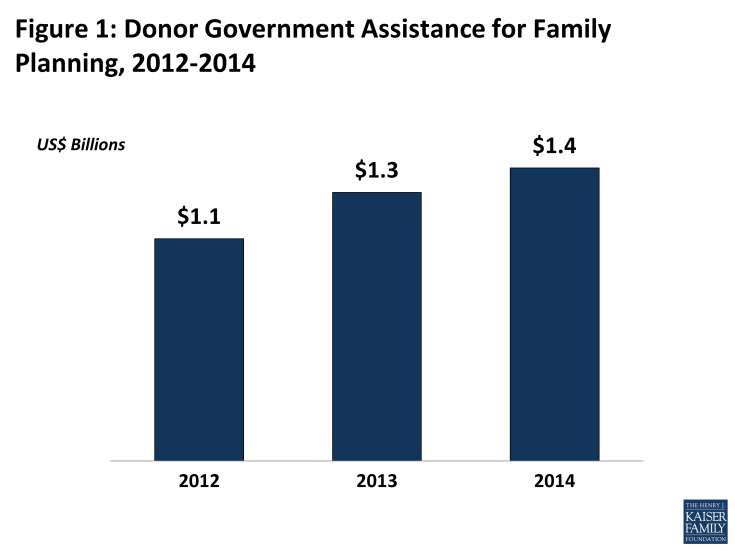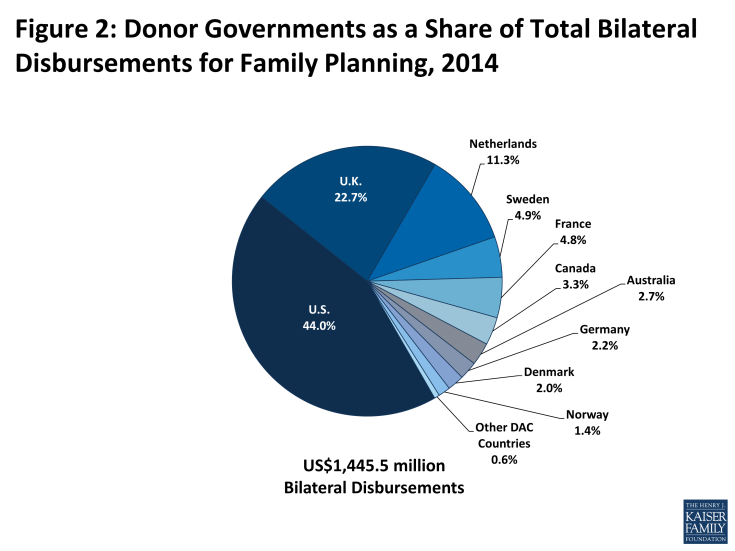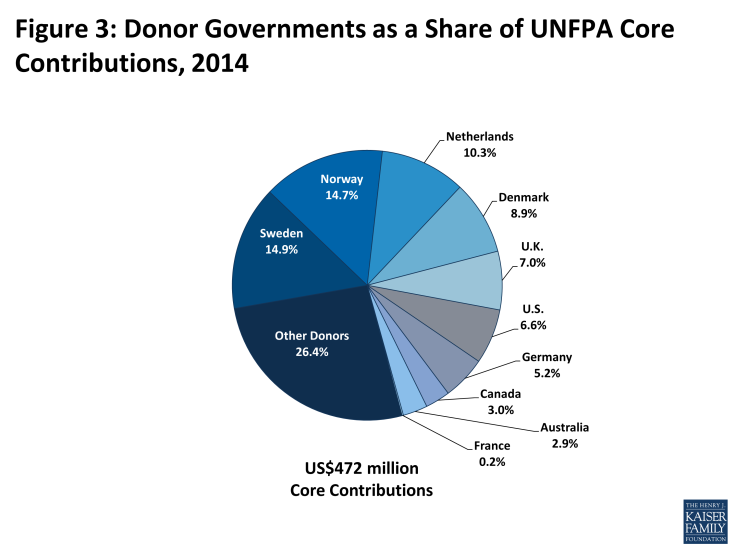Donor Government Assistance for Family Planning in 2014
Introduction
2015 marks the third year since the London Summit on Family Planning where the civil society organizations, developing countries, donor governments, the private sector, and multilateral organizations met and established specific goals for family planning (see Box 1). The global community also made commitments totaling US$2.6 billion in additional funding by 2020 for family planning activities. As the timeframe to reach the goals of the London Summit approaches the halfway point, it is important to assess progress made and discuss plans moving forward, particularly in the area of funding. The status of global funding for family planning activities takes on added relevance following the conclusion of the Millennium Development Goal (MDG) era and adoption of the new Sustainable Development Goals (SDGs).
| Box 1: London Summit on Family Planning |
| In July 2012, the U.K. Government and the Bill & Melinda Gates Foundation, in partnership with UNFPA, civil society organizations, developing countries, donor governments, the private sector, and multilateral organizations met at the London Summit on Family Planning (FP2020) and made commitments aimed at improving access to voluntary family planning services.
London Summit on Family Planning Goals & Outcomes: “By 2020, the goal is to deliver contraceptives, information, and services to a total of 380 million women and girls in developing countries so they can plan their families.”
|
While funding from all sources – domestic public and private spending, donor government bilateral assistance, multilateral organizations and private philanthropy (see Box 2) – is needed to help fulfill international family planning goals and commitments, donor governments provide a significant share of global funding.1 Following the London Summit, the Kaiser Family Foundation conducted an analysis of donor government funding for family planning activities in 2012 to establish a FP funding baseline that could be used to track funding levels over time as well as specific donor government progress in meeting the Summit’s commitments.
| Box 2: Other Sources of Funding for FP in Low- & Middle-Income Countries |
| In addition to donor governments, there are three other major funding sources for family planning assistance: multilateral organizations, the private sector, and domestic resources.
Multilateral Organizations: Multilateral organizations are international organizations made up of member governments (and in some cases private sector and civil society representatives), who provide both core contribution support and donor-directed funding for specific projects. Core support from donors is pooled by the multilateral organization which in turn directs its use, such as for family planning. Donor-directed or earmarked funding, even when provided through a multilateral organization, is considered part of a donor’s bilateral assistance. The primary multilateral organization focused on family planning is the United Nations Population Fund (UNFPA), which estimates that it spent US$334 million (US$93 million from core resources and US$241 million from non-core resources), or 40.7% of its total resources, on family planning activities in 2014.2 Another important source of multilateral assistance for family planning is the World Bank which provides such funding under broader population and reproductive health activities. In 2014, the World Bank estimates that it spent US$251 million on population and reproductive health, an increase of US$30 million above the 2013 level (US$221 million).3 With the creation of the Global Financing Facility (GFF), the World Bank is expected to play an increasingly important role in supporting family planning activities. Private Sector: Foundations (charitable and corporate philanthropic organizations), corporations, faith-based organizations, and international non-governmental organizations (NGOs) provide support for FP activities in low- and middle-income countries not only in terms of funding, but through in-kind support; commodity donations; and co-investment strategies with government and other sectors. For instance, the Bill & Melinda Gates Foundation has become a major funder of global health efforts, including family planning activities, and is a core partner of FP2020. In 2014, the Gates Foundation provided US$156 million for family planning, a US$22 million increase above 2013 levels. Domestic Resources: Domestic resources include spending by country governments that also receive international assistance for FP and spending by households/individuals within these countries for FP services. Such resources represent a significant and critical part of the response. Since the London Summit, a total of 36 low- and middle-income countries have made specific commitments to increase their family planning spending. |
This report provides donor government bilateral funding for family planning activities in 2014 compared to prior year levels. It includes an analysis of funding provided by the 29 governments who were members of the OECD DAC in 2014. Data were collected directly from ten donors, who represent approximately 99% of bilateral family planning funding, and are profiled in this report: Australia, Canada, Denmark, France, Germany, Netherlands, Norway, Sweden, the U.K., and the U.S. Data for the remaining DAC members was obtained from the OECD CRS. For purposes of this analysis, family planning services were defined to include the following activities as specified in the CRS: “counseling; information, education and communication (IEC) activities; delivery of contraceptives; capacity building and training.”4 Bilateral totals include actual funding amounts provided (e.g., cash transfers) as well as other types of transactions and activities (e.g., technical assistance), products (e.g., commodities), and donor government earmarked contributions to multilateral organizations (e.g. contributions to the Global Programme to Enhance Reproductive Health Commodity Security at UNFPA).
Where bilateral family planning funding was included as part of broader reproductive and maternal health activities or other non-health-sector activities, we worked directly with donor governments to identify family planning specific amounts to the extent possible (see Methodology for more information). Where it was not possible to disaggregate FP funding from broader reproductive and maternal health activities, the estimated level of family planning funding may be an overestimate. At the same time, some family planning funding provided under non-health-sectors remains largely unidentified, likely resulting in an underestimate of total family planning funding.
Findings
Bilateral Assistance
In 2014, donor governments disbursed5 US$1,445.5 million in bilateral funding for family planning activities (see Table 1, Figure 1 & Appendix 1), an increase of US$120.5 million (9%) above 2013 levels (US$1,325.0 million) and 32% (+US$349.1 million) above 2012 levels (US$1,096.4 million).
Among the donor governments profiled, seven (Canada, Denmark, France, Netherlands, Sweden, U.S., and U.K.) increased bilateral funding in 2014 (after exchange rate fluctuations are taken into account); two donors (Australia and Norway) remained essentially flat and one donor (Germany) decreased funding for family planning in 2014 (although, Germany increased funding for broader reproductive health activities). Most of the overall increase was due to increases in funding by the U.S., France, the U.K., and Sweden.
The United States (US$636.6 million) was the largest bilateral donor in 2014 accounting for almost half (44%) of total bilateral assistance (see Figure 2). The U.K. (US$327.6 million, 23%) was the second largest bilateral donor, followed by the Netherlands (US$163.6 million, 11%), Sweden (US$70.2 million, 5%), and France (US$69.6 million, 3%).
Progress Towards FP2020 Commitments
Eight of the donor governments surveyed directly made multi-year commitments at the FP2020 Summit in 2012: Australia, Denmark, France, Germany, Netherlands, Norway, Sweden, and the U.K. (see Appendix 2). While it is not possible to know what funding amounts would have been provided by donors in the absence of the Summit, data collected for 2012-2014 indicate that funding has increased since the 2012 baseline level and all donors are currently on track to fulfill their stated commitments. While the goals of the FP2020 Summit have a 2020 deadline, commitments from four of the donors profiled (France, Germany, the Netherlands, and Sweden) will conclude in 2015 and one donor (Australia) will conclude in 2016. Future analyses will continue to monitor funding disbursed towards these commitments as well as the trends once commitments have concluded.
Donor Contributions to UNFPA
While the majority of donor government assistance for family planning is provided bilaterally, donors also provide support for family planning activities through contributions to the United Nations Population Fund (UNFPA) (see Box 3). Most of UNFPA’s funding is from donor governments, which provide funding in two ways: 1) donor directed or earmarked contributions for specific activities (e.g. donor contributions to the Global Programme to Enhance Reproductive Health Commodity Security at UNFPA), which are included as part of bilateral funding; and 2) general contributions to “core” activities that are untied and meant to be used for both programmatic activities (family planning, population and development, HIV-AIDS, Gender, and sexual and reproductive health and rights) and operational support as determined by UNFPA.
|
Box 3: United Nations Population Fund (UNFPA) Mission, Mandate, & London Summit on
Family Planning Commitment
|
| Created in 1969, UNFPA supports sexual and reproductive health activities in many low- and middle-income countries and was a key partner in the London Summit on Family Planning.
UNFPA Mission: Deliver a world where every pregnancy is wanted, every birth is safe, every young person’s potential is fulfilled. UNFPA Mandate:
UNFPA London Summit on Family Planning Commitment: “UNFPA will double the proportion of its resources focused on family planning from 25% to 40 % based on current funding levels, bringing new funding of at least US$174 million per year from core and noncore funds. This will include a minimum of US$54 million per year, from 2013-2019, in increased funding for family planning from UNFPA’s core resources.” |
In 2014, donor governments provided US$472 million in core contributions to UNFPA, an increase of US$15 million (3%) above 2013 levels (US$457 million) and US$34 million (8%) above 2012 levels (US$438 million). Sweden was the largest donor to UNFPA (US$70.3 million, 15%), followed by Norway (US$69.1 million, 15%), the Netherlands (US$48.4 million, 10%), Denmark (US$41.9 million, 9%), the U.K. (US$33.1 million, 7%), and the U.S. (US$31.1 million, 7%) (see Figure 3).6 Among the ten donors profiled, two provided a larger contribution to UNFPA’s core resources than their total bilateral disbursement for family planning: Denmark and Norway.
| Table 2: Donor Government Contributions to UNFPA (Core Resources), 2012-2014 (US$ millions) | |||||
| Country | 2012 | 2013 | 2014 | Difference* | |
| 2013 – 2014 | 2012 – 2014 | ||||
| Australia | $14.9 | $15.6 | $13.9 | -$1.7 | -$0.9 |
| Canada | $17.4 | $16.0 | $14.0 | -$2.0 | -$3.3 |
| Denmark | $44.0 | $40.8 | $41.9 | $1.1 | -$2.1 |
| France | $0.5 | $0.5 | $0.7 | $0.2 | $0.2 |
| Germany | $20.7 | $24.0 | $24.7 | $0.7 | $3.9 |
| Netherlands | $49.0 | $52.4 | $48.4 | -$3.9 | -$0.6 |
| Norway | $59.4 | $70.6 | $69.1 | -$1.4 | $9.7 |
| Sweden | $66.3 | $65.8 | $70.3 | $4.5 | $4.0 |
| U.K. | $31.8 | $31.5 | $33.1 | $1.5 | $1.3 |
| U.S. | $30.2 | $28.5 | $31.1 | $2.7 | $0.9 |
| Other Donors | $103.3 | $111.4 | $124.6 | $13.2 | $21.4 |
| Total | $437.5 | $457.1 | $471.9 | $14.8 (3.2%) |
$34.4 (7.9%) |
Conclusion
Donor government funding for family planning increased in 2014 marking the second consecutive year of increases since donors made commitments to increase funding at the London Summit on Family Planning in 2012. Additionally, the eight donor governments profiled who made commitments at the London Summit are all on track towards fulfilling them. Looking ahead, however, it is not yet certain if these trends will continue, as several donors are nearing the end of their commitment period and overall bilateral development assistance is projected to be constrained among many of the donor governments.7 It will therefore be important to continue tracking funding for family planning activities to assess progress towards addressing ongoing family planning needs in low- and middle-income countries.



